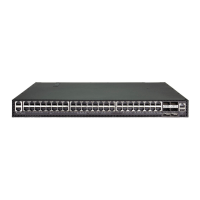C
HAPTER
8
| Spanning Tree Algorithm
Configuring Global Settings for STA
– 240 –
CONFIGURING GLOBAL SETTINGS FOR STA
Use the Spanning Tree > STA (Configure Global - Configure) page to
configure global settings for the spanning tree that apply to the entire
switch.
CLI REFERENCES
◆ "Spanning Tree Commands" on page 1057
COMMAND USAGE
◆ Spanning Tree Protocol
2
This option uses RSTP set to STP forced compatibility mode. It uses
RSTP for the internal state machine, but sends only 802.1D BPDUs.
This creates one spanning tree instance for the entire network. If
multiple VLANs are implemented on a network, the path between
specific VLAN members may be inadvertently disabled to prevent
network loops, thus isolating group members. When operating multiple
VLANs, we recommend selecting the MSTP option.
◆ Rapid Spanning Tree Protocol
2
RSTP supports connections to either STP or RSTP nodes by monitoring
the incoming protocol messages and dynamically adjusting the type of
protocol messages the RSTP node transmits, as described below:
■
STP Mode – If the switch receives an 802.1D BPDU (i.e., STP BPDU)
after a port’s migration delay timer expires, the switch assumes it is
connected to an 802.1D bridge and starts using only 802.1D
BPDUs.
■
RSTP Mode – If RSTP is using 802.1D BPDUs on a port and receives
an RSTP BPDU after the migration delay expires, RSTP restarts the
migration delay timer and begins using RSTP BPDUs on that port.
◆ Multiple Spanning Tree Protocol
MSTP generates a unique spanning tree for each instance. This provides
multiple pathways across the network, thereby balancing the traffic
load, preventing wide-scale disruption when a bridge node in a single
instance fails, and allowing for faster convergence of a new topology for
the failed instance.
■
To allow multiple spanning trees to operate over the network, you
must configure a related set of bridges with the same MSTP
configuration, allowing them to participate in a specific set of
spanning tree instances.
■
A spanning tree instance can exist only on bridges that have
compatible VLAN instance assignments.
2. STP and RSTP BPDUs are transmitted as untagged frames, and will cross any VLAN
boundaries.
